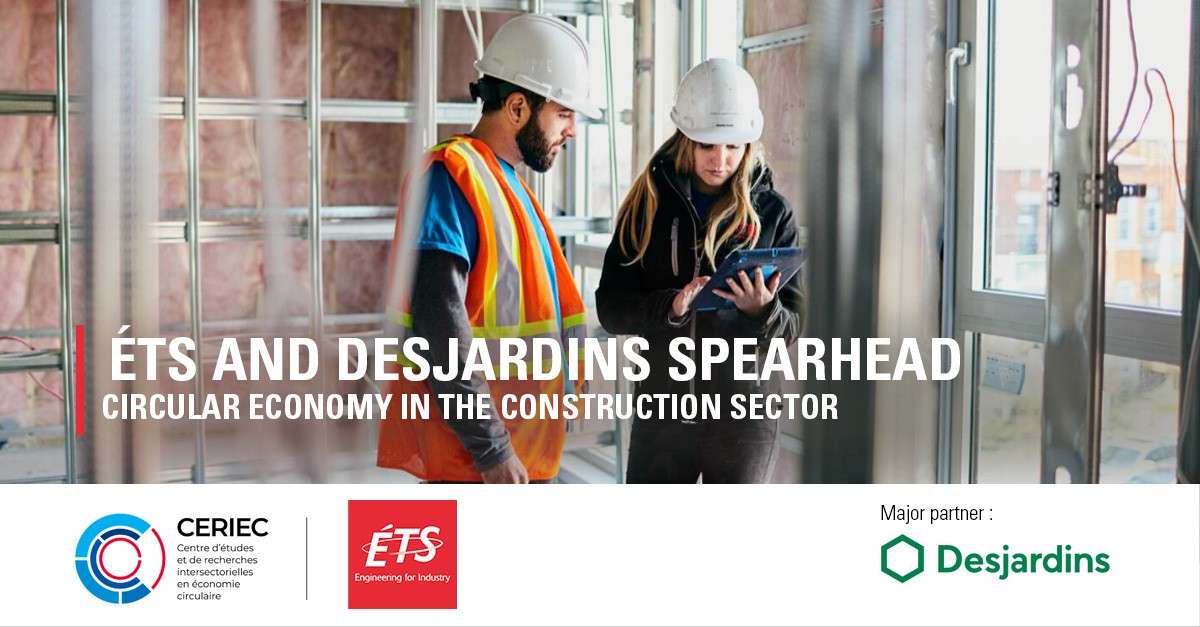A Circular Economy Living Lab in the Construction Sector
Émilie Chiasson

The team of the Centre for Intersectoral Studies and Research in Circular Economy (CERIEC) of the École de technologie supérieure (ÉTS) announces the launch of its first living lab.
With the help of stakeholders, this lab will identify the obstacles standing in the way of circularity for targeted resources in the Québec construction sector. It will allow then to co-create solutions aimed at integrating and generalizing circular economy strategies in this sector, using innovative pilot projects.
The initiative is made possible by a $2.1 M contribution over five years from Desjardins, a major partner in a new network of circular economy living labs (ELEC), of which this first lab is part of.
Construction: a priority sector for circular economy
As a major sector of the Québec economy (7.7% of GDP) and a large generator of heterogeneous residual materials, the construction sector is the ideal candidate for this first circular economy living lab.
Over a period of three years, key players in the construction value chain and researchers from different fields will work on the challenges this sector will encounter through its transition to circular economy.
The aim is to increase resource productivity at all stages of the life cycle, to reduce the use of virgin resources used in construction and renovation of buildings, and to move towards zero waste.
Concrete impacts for the building sector in Québec
This construction living lab will set up pilot projects to render industry practices more responsible, more sustainable and more circular. It will also support the maturation or creation of new companies to exploit the technologies and knowledge generated. This will offer new entrepreneurial opportunities and weave new links within the ecosystem of actors.
This approach will also develop additional pathways to achieve GHG reduction targets in an innovative way and reduce the environmental impacts of this industry.
Quotes
“It is essential to further circularize the construction sector, which in Québec alone generates more than 3 M tonnes of residual materials each year, in addition to being a major consumer of primary resources. With this lab, we want to generate commitment and accelerate the search for solutions with the players in this industry towards a more circular and sustainable economy.”
- Daniel Normandin, Director, CERIEC
“Desjardins is proud to be associated with this first circular economy living lab that focuses on the construction sector. We know that most of the waste generated by this sector ends up in landfills or in GHG-emitting fuels. The lab's work will improve practices in this industry to provide greener housing and commercial facilities. It is important to accelerate and multiply this type of projects that will contribute directly to the development of a sustainable economy focused on the well-being of people and communities.”
- Guy Cormier, President and CEO, Desjardins Group
“Innovation in construction means equipping ourselves with the right tools for the future. It means thinking collectively and building our future with a greener and more environmentally friendly foundation. The ÉTS is proud to be an agent of change and to have participated in the creation of this new lab aimed at optimizing and better using materials for a sustainable economy.”
- François Gagnon, Director General, ÉTS
About circular economy
The circular economy is a production, exchange and consumption system aiming to optimize resource use at every stage in the life cycle of a product or service through a circular approach, reduce the environmental footprint and contribute to the well-being of individuals and communities.
For more information: www.quebeccirculaire.org
About CERIEC
Established in September 2020 at ÉTS, CERIEC endeavours to help shape and deploy a circular economy. To do so, it intends to implement an interdisciplinary scientific research program as well as initiatives that revolve around training, dialogue, added-value and knowledge transfer. These actions aim to maximize the benefits for economic players, governments and civil society.
For more information: www.ceriec.ca



